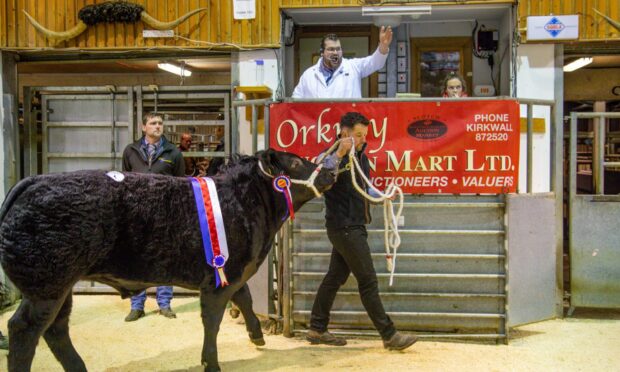Despite declining cow numbers and growing input costs, Orkney Auction Mart has declared a successful year of livestock sales through its centre in Kirkwall.
Graham Low, who joined the company eight years ago as a trainee, is now senior auctioneer and said he is “really pleased” with how this year went, as numbers have remained similar on the year, with 600 more deadweight cattle procured by the firm.
Mr Low said that just shy of 11,500 stores had been sold in 2022, along with 360 prime, more than 1000 OTMs, 500 breeders and 1700 deadweight cattle which go to McIntosh Donald.
A new extension was also added to the building this year to accommodate more pens and additional lairage.
“Very few cattle are finished on Orkney due to little crops being grown so we rely heavily on store cattle up here, with most farmers following the traditional system of selling 18-month-old stores in September or as yearlings in the spring,” added Mr Low.
“Most of the beef cows are out on the isles such as Stronsay, Sanday, Westray and Shapinsay, and the progeny is well sought after by the south buyers because they go on and thrive.
“Our bigger store sales in the spring and autumn usually attract 12 to 14 buyers from Aberdeenshire, and we get a few coming off the Edinburgh flight and across from Caithness.”
He said that the price of store cattle in the spring was back on last year’s levels, purely down to the finishing costs, but added that the December sale was the dearest of 2022, with bullocks averaging 245p per kg (+20p on the year) and heifers cashing in at 241p per kg (+27p).
“Farmers are watching their costs so we could have more producers offloading earlier and selling their store cattle in the spring,” he added.
“Just over 40% of the store cattle sold this year were Charolais, with Aberdeen-Angus and Limousins both at 16%, closely followed by Simmentals at 14%.”
Mr Low said that the weekly prime cattle sales were supported by three local butchers on Orkney and one from Stirling.
He said that butchers have been very selective in what they are buying and are aiming to source handy weight cattle around the 550kg mark, while working around the high logistic costs.
“These butchers on Orkney are paying a premium price for these animals, purely down to getting them slaughtered and back to the island,” he added.
“The prime cattle are usually shipped across to Scrabster the morning after the sale, hauled to Munros in Dingwall, where they are slaughtered, and then brought back up to Orkney at the end of the week.”
Alongside the cattle sales, the company has sold more than 35,000 sheep through the centre, which is up 2000 head on the year.
Just over 40% of the store cattle sold this year were Charolais, with Aberdeen-Angus and Limousins both at 16%, closely followed by Simmentals at 14%.”
Graham Low
This figure includes more than 14,000 prime lambs, 12,630 store lambs and 5800 cast sheep.
Mr Low said that the mart was hit with big but lean lambs this year despite one of Orkney’s best growing seasons for grass. He added that the wet weather throughout the back end encouraged sheep farmers to sell their lambs earlier.
Looking ahead, he said he remained optimistic about the future of beef cattle on Orkney, but was concerned about the age group population on the island.
“At the end of the day, people still have to eat and the quality of Orkney cattle is still at a very high standard and in strong demand,” he said.
“Our industry needs to work harder to encourage youngsters to get involved. It’s frightening how few young farmers there is on Orkney and some farms have nobody coming behind.”
The mart will hold its annual show and sale of breeding bulls on Wednesday, January 25th, as well as the dispersal sale of top-quality Aberdeen-Angus cross cows from Raymond & Linda Flaws, Nisthouse, Evie.
